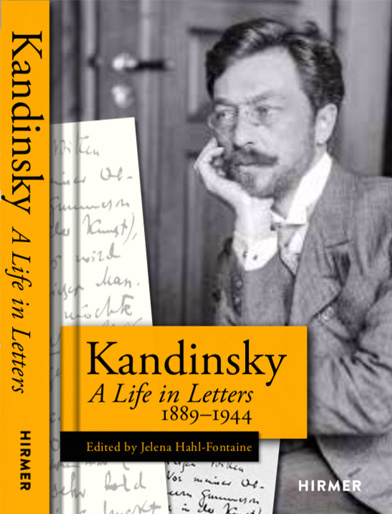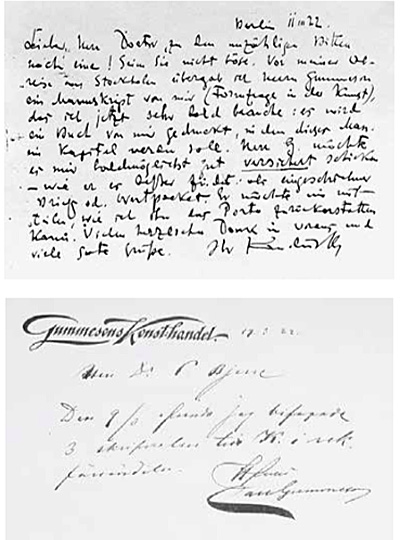|
Introductory Remark
New information about
Kandinsky has continued
to surface over time,
often bringing with it
new questions.
Readers of this series
know the eminent Dr.
Hahl-Fontaine on a
first-name basis, as
"Jelena."
Jelena has collected
and selected
Kandinsky's letters
for a new
book—most of them
published for the first
time, and all of them
appearing in
incontrovertible
context. Historic. An
incalculably clarifying
contribution, newly
out—or about to
be any minute
now—in English.
"Kandinsky
Anew" indeed;
proud to feature this
interview with her for
this series.
Lissa Tyler Renaud
*

Photo of Kandinsky by Gabriele Münter, Dresden, 1905, Gabriele Münter-Johannes
Eichner Foundation, Munich. VG-Bild-Kunst, Bonn.
Historic: Kandinsky's Unpublished Letters, Published
Renaud Interviews Hahl-Fontaine
Lissa Tyler Renaud: What gave you the idea to edit a volume of
Kandinsky's letters?
Jelena Hahl-Fontaine: Since 1980, when I first published the Kandinsky
-Arnold Schoenberg correspondence, I have stayed faithful to my favorite
artist. The same year, after publishing his biographical book on Kandinsky,
the Museum director of Lenbachhaus Munich, Hans K. Roethel, and I
agreed that primary sources should always take priority, before the
historians start writing their interpretions. So we prepared six more
volumes, which never appeared (I don't want to talk about those ugly
manipulations...). Twenty-five years later those writings were published in
Paris, but most of the letters still remained unknown. So this task tempted
me, and the selection turned into a great joy.
LTR: The German version of the book is very handsome and compact. Also
for the English one, clearly your goal wasn't to publish all of Kandinsky's
letters this time.
JH-F: Oh, heavens no! That would amount to at least 20 volumes! Of
course this necessary work will be done one day. Just as now all of Marcel
Proust's letters have been edited: in 21 volumes. But when I started
searching for the most interesting letters—imagine, among so much
repetition and nonsense, I just gave up.
LTR: So there are still thousands of letters we've never seen. How did you
choose from so many?
JH-F: I selected the most important, least known, most unusual and witty
parts, and also included some typical, everyday things. It helped that I
know almost all his letters. I also know his theoretical writings—I had
translated a large heap of his Russian ones into German. I would like to
stress that I found not a single ugly letter.
I'm sure you will be disappointed to find too little about theatre! But this
subject is well covered in the correspondence with Arnold Schoenberg, and
my English edition of 1984 is still findable, available. Also I did not include
very many of Kandinsky's letters to his best friend and theatre collaborator,
the composer Thomas de Hartmann, because their whole, so
far totally unknown correspondence will soon be published in Israel.
LTR: But there are quite a few mentions of the theatre—both of his own
work and others'. Even though they tend to be brief, they are striking. And
it's gratifying to me that they keep surfacing across the decades, since the
longevity and persistence of his theatre interests have been one of the
foundational claims in my own work.
Of course the letters you chose to include or leave out create a certain
impression of Kandinsky for the readers, yes?
JH-F: I would like to say that I did not pick only letter-parts that give a
"favorable" view of the artist. My selection is neutral; I chose fairly. There
are parts, for example, where some readers will be shocked by his
opinions—for example, about Dalí, the Surrealists, the Constructivists—and
disagree with him. If I were partial, I could simply have omitted those. I
believe every reader should be free to judge Kandinsky for
him- or herself!!
LTR: And of course, even the book's layout makes an impression: you
provided your commentary directly into the text, in brackets, not in
footnotes on the page or in endnotes at the ends of chapters—both so
annoying. And the year that the letter pertains to is at the head of each
page. These add to making reading the book a pleasure.
I see on the author page that you also worked closely with Dr. Kate
Kangaslahti.
JH-F: Yes, thank you again for finding her. Kate studied at Oxford, and is
now teaching in Belgium at the University of Leuven. She did a marvelous
job: finalizing, suggesting alterations. And what is more, she is living
almost "next door" to us in Brussels. So our cooperation turned out just
perfect!
*

Postcard from Kandinsky to Poul Bjerre, Stockholm, Mar. 11, 1922, and a note in Swedish
from Carl Gummeson to Poul Bjerre: "To Dr. P. Bjerre. I sent 3 texts to K. on 9/3—special
delivery. Greetings, Carl Gummeson."
LTR: So, in a sense, you've had this book in mind for decades.
JH-F: I have accumulated the material for the book for over 60 years! And found it extremely interesting, not only "art-historically, "but also "art
-politically," and even politically. Especially since many of the letters have
never been published yet, almost half of my selection is new. Astonishing,
since there is incredibly much literature about Kandinsky.
LTR: Oh, finally knowing more of Kandinsky's political opinions in his own
words will be very important. Long overdue. From the way his writings
have been edited for so long, you would never know how profoundly world
events figured in every aspect of his life.
JH-F: Yes, for example, during the Nazi era, he dared to write to a Swiss
friend: "All this mess because of a mad lunatic."
LTR: Do you think the letters have special relevance now?
JH-F: Still today, Kandinsky's idea to create an international peace
movement, together with "those people who are alive today but are
concerned about tomorrow," is just as important as it was 1914, shortly
before the beginning of World War 1. Wouldn't that be a good idea today as
well?
LTR: After re-reading everything so closely during the selection process,
and preparing the manuscript, was there anything that surprised you?
JH-F: Yes, indeed. The extent of Kandinsky's helpfulness towards
colleagues; also his occasional very sharp and witty attacks. Also, his
resilience in often very hard times. I was surprised all over again how
much livelier and more vivid his letters are than his other, theoretical
writings: witty, beautiful, ironical and warmhearted letters.
LTR.: Your book came out in that German edition early this year. Did you
make any adjustments for the English edition that's being printed now?
JH-F: Yes, I shortened some specifically German material and added other
letters instead. And Kate Kangaslahti found important additions: letters to
Ben Nicholson, Alfred Barr and Herbert Read. We added a letter he wrote
to Marinetti asking for a letter of support to save the Bauhaus from being
shut down by the Nazis.
LTR: Oh, I saw that Marinetti letter—it's so good that that's in your book!
And the others you've added, too: crucial. Your volume of letters will add a
lot of new information for everyone interested in Kandinsky, the people
around him, and his time.
JH-F: Overall, the book corrects certain mistaken ideas people have about
his character. My book should also be an incentive to other scholars, for
instance to edit his experimental theatre work and his prose poems. There
is still unpublished material to work on; it would make me very happy for
someone to do that. And since Kandinsky was not only a painter, but such a
rich, manifold personality, hopefully the interest in him will never end.
* * *
|